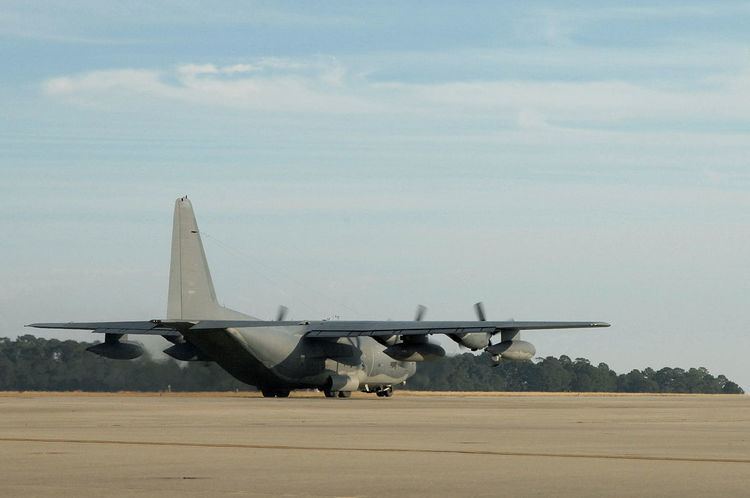Country United States | Role Special Operations | |
 | ||
Active 1942–1943; 1944–1946; 1947–1949; 1968–1970; 1992–present Part of Air Force Special Operations Command1st Special Operations Wing1st Special Operations Group | ||
The 15th Special Operations Squadron is part of the 1st Special Operations Wing at Hurlburt Field, Florida. It operates Lockheed MC-130H Combat Talon II aircraft in support of special operations.
Contents
- Mission
- History
- Antisubmarine warfare
- B 29 Bombardment squadron
- Combat Talon
- Lineage
- Assignments
- Stations
- Aircraft Operated
- Operations
- References
The squadron was first activated in 1942 as the 520th Bombardment Squadron. It engaged in antisubmarine warfare operations as the 15th Antisubmarine Squadron off the Atlantic coast of the United States until 1943 when the Navy assumed responsibility for the mission. It was disbanded in the fall of that year.
In 1944, the 15th Bombardment Squadron, Very Heavy was activated as a Boeing B-29 Superfortress unit. It participated in combat operations against Japan in 1945, receiving a Distinguished Unit Citation. The squadron was inactivated on Guam in 1946. It was again briefly active in the Air Force Reserve from 1947 to 1949.
The 15th Special Operations Squadron was activated in Vietnam as a Lockheed C-130 Hercules gunship squadron. It participated in combat until it was inactivated in 1970, earning a Presidential Unit Citation (United States), Air Force Outstanding Unit Award with Combat V device and Republic of Vietnam Gallantry Cross with Palm.
The 15th Antisubmarine Squadron and 15th Bombardment Squadron were consolidated with the 15th Special Operations Squadron in September 1985, but remained inactive until 1992, when the squadron again activated as a special operations C-130 unit.
Mission
Global, day and night, adverse weather capability to insert, extract, and resupply special operations forces by low or high altitude airdrop or airland operations.
History
The squadron was first established in late 1942 as the 520th Bombardment Squadron (Heavy) at Jacksonville Municipal Airport, Florida from a cadre of the former 18th Observation Squadron. It was reassigned from Third Air Force to Army Air Forces Antisubmarine Command in November and redesignated as the 15th Antisubmarine Squadron.
Antisubmarine warfare
The squadron was one of several hastily converted to dedicated antisubmarine duties in response to the German U-boat threat in the Atlantic and Caribbean regions during 1942 and 1943. It was re-equipped with a hodgepodge of aircraft that could be spared for antisubmarine patrol duties at the time, including various early North American B-25s, Lockheed B-34s and Douglas B-23s, and operated at several locations up and down the Atlantic seaboard (including Langley Field, Virginia and Drew Field, Florida) before deploying to Batista Field, Cuba on 3 August 1943 as an element of the 26th Antisubmarine Wing (although it had been attached to the 25th Antisubmarine Wing from 21 November 1942 until going to Cuba).
The squadron continued Antisubmarine operations over the South Atlantic coastline and the Gulf of Mexico from Drew Field, near Tampa Florida until August 1943 when the Navy took over the antisubmarine mission. It was disbanded on 2 November 1943.
B-29 Bombardment squadron
The 15th Bombardment Squadron, (Very Heavy) was activated as part of the 16th Bombardment Group on 1 April 1944 at Dalhart Army Air Field, Texas as a Boeing B-29 Superfortress unit. It moved to Fairmont Army Airfield, Nebraska for training in August 1944 and received Bell B-29B Superfortresses designed for fast low-level bomb runs. The squadron deployed to the Pacific Theater of Operations, where it was stationed at Northwest Field, Guam under XXI Bomber Command's 315th Bombardment Wing. It flew very long range strategic bombardment missions over the Japanese Home Islands concentrating on oil industry targets, particularly refineries and coal liquification facilities (26 June-14 August 1945). No B-29s from the squadron were lost during combat operations over Japan.
The squadron was inactivated on Guam 15 April 1946. Its personnel returned to the United States and its aircraft were sent to storage in the Southwest United States.
The squadron was briefly reactivated as a part of the Air Force Reserve between 1 August 1947 and 27 June 1949.
Combat Talon
The designation was revived and reactivated in Southeast Asia in 1968. The 15th Special Operations Squadron saw combat and performed special operations missions from 15 March 1968, to 31 October 1970, flying the C-130E (I) Combat Talon. The unit was again inactivated, but was consolidated with the 15th Antisubmarine Squadron and the 15th Bombardment Squadron in September 1985.
The 15th SOS was reactivated on 1 October 1992, to operate the MC-130H Combat Talon II and assigned to the 1st Special Operations Wing.
The Combat Talon was first operational as Detachment 1, 314th Troop Carrier Wing beginning 1 September 1966, as a support unit for MACV-SOG. On 15 March 1968, the detachment was designated the 15th Air Commando Squadron, and then the 15th Special Operations Squadron on 1 August 1968, and made part of the 14th Special Operations Wing. In Vietnam, the aircraft was used to drop leaflets over North Vietnamese positions, and to insert and resupply special forces and indigenous units into hostile territory throughout Southeast Asia. Combat Talon crews operated unescorted at low altitudes and at night.
Lineage
15th Antisubmarine Squadron
15th Bombardment Squadron
Constituted as the 15th Bombardment Squadron, Very Heavy on 28 March 1944Activated on 1 April 1944Inactivated on 15 April 1946Activated in the Reserve on 1 August 1947Inactivated on 27 June 194915th Special Operations Squadron
Constituted as the 15th Air Commando Squadron and activated, on 13 February 1968 (not organized)Organized on 15 March 1968Redesignated 15th Special Operations Squadron on 1 August 1968Inactivated on 31 October 1970